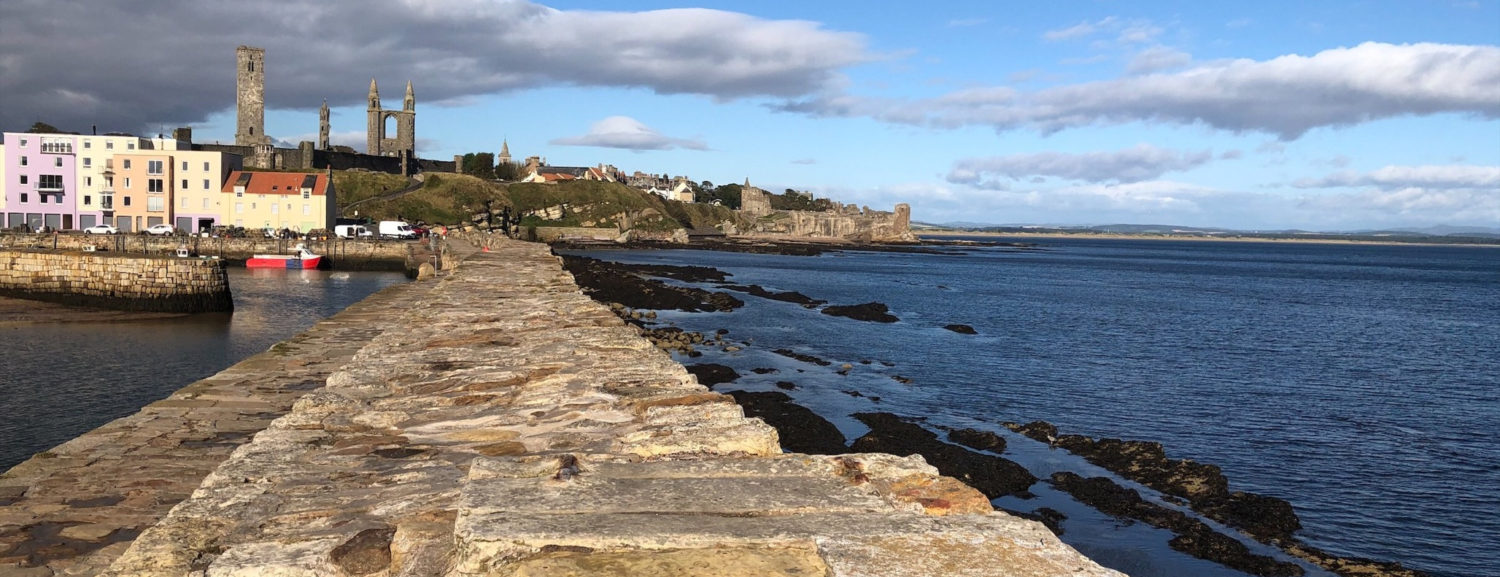Thomas Rodger (1832-1883) was the first professional photographer in St Andrews. The first of 9 children of Thomas Rodger Sr, a house painter and Elisabeth Greenhill, he studied chemistry at Madras College. After his apprenticeship with two local surgeons which he followed up by studying medicine for 2 years in the Andersonian College in Glasgow, Rodger gave up medicine for a career in photography having been persuaded by Dr John Adamson since Chemistry was closely linked to photography during that time.
As a pupil and laboratory assistant to Dr Adamson, he started as a ‘calotypist’ but would later move on to the Collodion Process in photography. Having been very proficient with the calotype process, he assisted Lord Kinnard who had a new found interest in photography.
Even at this early stage, Rodger was very talented in photography having won the Aberdeen Mechanics’ Institution Medal (1853) and the Edinburgh Photographic Society Medal(1856), possibly for his work- the Carte-de-Visites. Through his paper- ‘On Collodion Calotype’, for which he was awarded the Royal Scottish Society of Arts Medal, Rodger would explain the details of his process and the locations used, often garden outdoors (like the New York cottage and North Street).
By 1855, Rodger had become widely successful and well recognised since he had put forward twenty-two works in collodion for the photographic exhibition in the annual meeting of The British Association for the Advancement of Science.
He was acquainted with the members of Photographic Society of Scotland where he would discuss theories and techniques. Ivan Szabo, a protégé of Rodger, was nominated a member of this society in 1856 and would later move to Edinburgh to set up a studio of his own becoming equally famous.
In the first annual exhibition of the photographs of this society, Rodger received an immense amount of praise for his work exhibited.
“Nothing can exceed Mr Rodger’s power of catching a characteristic expression or attitude, and the tints are soft and delicate, though sufficiently decided.” (Sara Stevenson and A.D. Morrison-Low: Scottish Photography. The first 30 Years, p.135)
“Mr Rodger’s portraits are truly excellent, among the best, if not the very best of the moderns.” (Karen A. Johnstone: Thomas Rodger. A Biography and Catalogue of Selected Works, p.78)
By 1857, he was recognised as the towns’ “famed photographer” and was considered a photographic artist. Therefore, he was an obvious candidate to carry out studies on new photographic ideas such as the ‘Collodion Process’. In the exhibition of 1857, Rodger had produced works which were just as impressive as the previous year and had set up a competitive trend of producing works of excellence. By 1859, Rodger grew immensely as an artist developing his technique from studio portraiture and local scenes to a more directed, and commercially viable publication. He reached the peak of his career around this time and didn’t even bother advertising after 1857.
He would go on to take pictures of several prominent individuals such as Lieut., Colonel Sir Hugh Lyon Playfair, James David Forbes, Principal of the United College of St. Salvator (who described him as a genius & perfectionist) and even photographed Prince Alfred. From various letters that talk about him, we can see that Rodger considered himself more of an artist than a clever scientist who believed that as much as the science of photography had accomplished, there was yet a wider field open. He would also take an active part in the local community being a member of various committees while also entertaining children .
Thomas Rodger was married to Margaret with whom he’d have 5 children. He died in St Andrews on the 6th January 1883 leaving behind 2 sons and 2 daughters. He was famous for his individual portraits and his pictorial record of the town, its people, the fisher folk and eminent visitors bought him great fame. He built the first photographic studio of the town and had achieved immense recognition for the proficiency of his work and his knowledge and experimentation with various materials. Along with David Brewster and John Adamson, Rodger made St Andrews the centre of world photography.
Sources, additional reading & pictures for Thomas Rodger’s house and studio:-
- Resources for Thomas Rodger’s House and studio: https://www.nationalgalleries.org/art-and-artists/artists/thomas-rodger
- Museum Photo Collection: https://www.getty.edu/art/collection/artists/2643/thomas-rodger-scottish-1832-1883/
- National Photography Gallery: https://www.npg.org.uk/collections/search/person/mp83866/thomas-rodger
- University of St Andrews Photo Collections: https://collections.st-andrews.ac.uk/search/?query=Thomas+Rodger&form=grid&mode=query
- Additional Info and Photos by Francesco Alessandrini Lupia: https://exhibit.so/exhibits/r1Pnnbk16IiHcGveZuju?type=scroll
- Google arts & culture: https://artsandculture.google.com/entity/thomas-rodger/m0k8_fn6?hl=en
- Karen A Johnstone’s PHD thesis on Thomas Rodger (bio): https://research-repository.st-andrews.ac.uk/handle/10023/15090
Other Info: Scottish Photography Archive, Edinburgh and The John Paul Getty Museum, Malibu.
